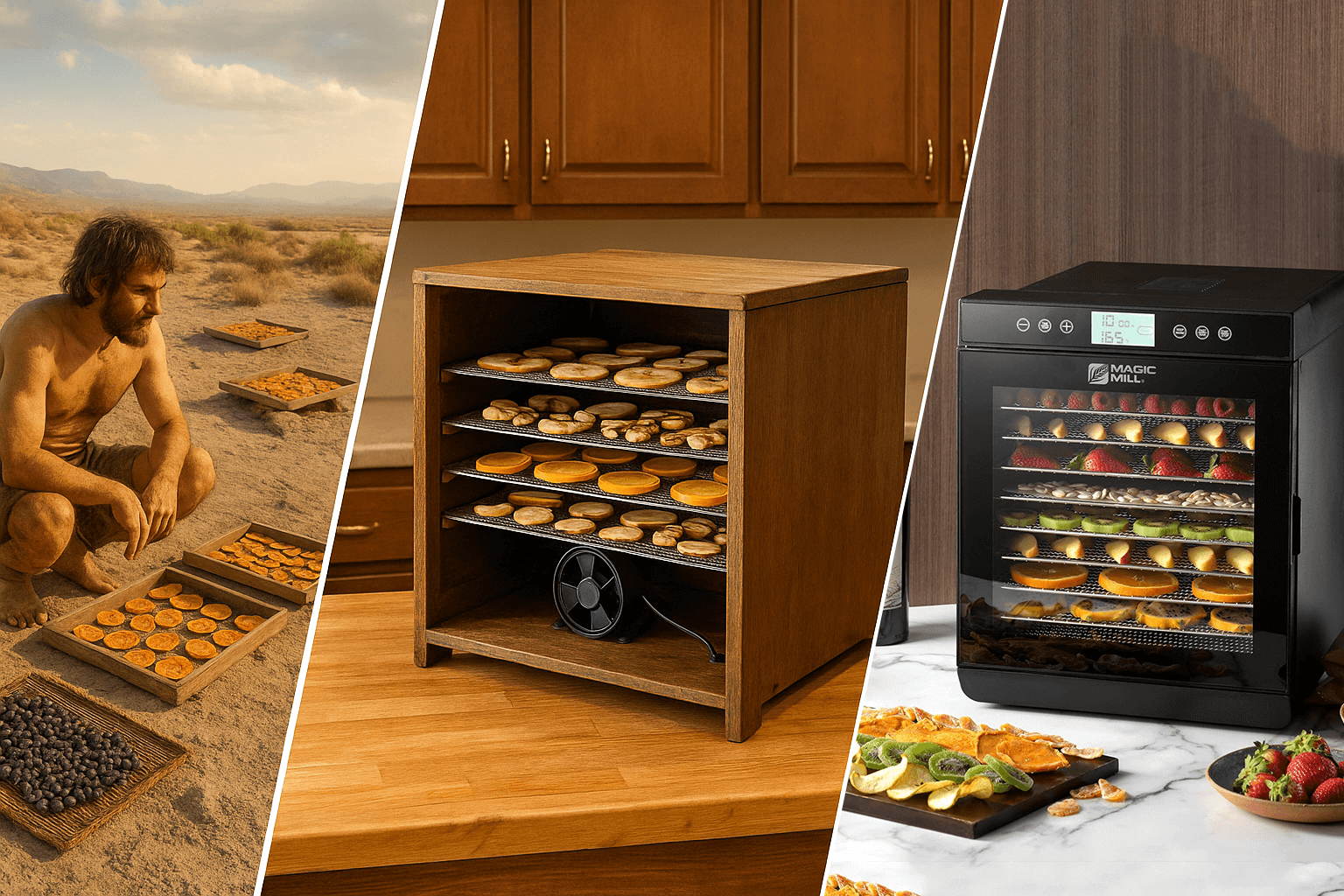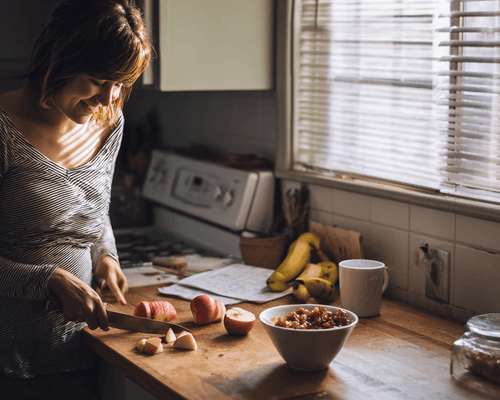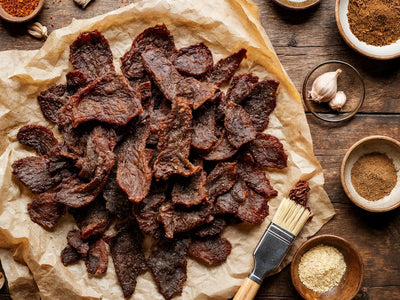The Evolution of Home Dehydrators: From Ancient Sun-Drying to Modern Kitchen Tech
| | 5 min read
Ever wonder how we went from laying fruit under the sun to using high-tech machines that make perfect banana chips at the push of a button? Whether you're a homesteader, a foodie, or just someone fascinated by kitchen gadgets, you're about to uncover a story as rich and layered as a tray full of apple slices in a dehydrator.
This whimsical journey will take you from ancient Egypt to 1980s infomercials and into today’s smart kitchen. So grab a snack (maybe some jerky?) and settle in.
Table of Contents
- Ancient Origins: Sun, Wind, and the First “Dehydrators”
- Medieval “Still Houses” and Renaissance Experiments
- The First Dehydration Machines (1795): A Scientific Leap
- Wartime Kitchen Hack: Home Dehydrators in World War II
- The 1960s: Dehydrators Debut in Homes
- Innovation in the 1970s: A Breath of Fresh Air
- 1980s & 1990s: Dehydrators Go Mainstream
- The 21st Century: High-Tech Drying and DIY Revival
- Conclusion: From Sun-Dried to Super-Dry
- Sources
Ancient Origins: Sun, Wind, and the First “Dehydrators”
The story of food dehydration begins over 14,000 years ago, when our ancestors first discovered that the sun and wind could preserve food. Ancient Egyptians dried fish and dates, laying them on flat rooftops to soak up the arid sun. Indigenous peoples of the Americas made jerky by hanging meat over wooden frames in breezy, sunny spots. In Asia, rice and herbs were dried on woven mats laid across stone courtyards.
It wasn’t science—it was survival. Dehydration allowed people to preserve calories for lean seasons and travel. These natural methods were accessible, requiring only sunlight, airflow, and patience.
Medieval “Still Houses” and Renaissance Experiments
By the Middle Ages, wetter European climates demanded new solutions. Enter the “still house,” a sort of food-drying cabin equipped with low fires and ventilation. These were the ancestors of indoor dehydrators. In England and Germany, these rustic sheds preserved apples, pears, herbs, and even meat.
The Renaissance period also saw experimentation with preserving flavor as well as food. In Italy and France, herbalists and cooks began perfecting the drying of lavender, basil, and rosemary. It was not just about survival anymore—it was about enhancing cuisine.
The First Dehydration Machines (1795): A Scientific Leap
Fast forward to Enlightenment-era France. In 1795, inventors Masson and Chollet created one of the first heated air-dehydration machines. It gently blew warm air over sliced produce, then sealed the dried results in tin foil. This method became a model for early military rations and long sea voyages.
Napoleon's army benefited from this preservation technology, which allowed dried vegetables and fruits to be stockpiled and transported easily. It was a huge leap from drying fruit on your windowsill.
Wartime Kitchen Hack: Home Dehydrators in World War II
During World War II, families were encouraged to grow and preserve their own food. With canning supplies limited, the USDA approved the production of over 100,000 home food dehydrators.
These weren’t high-tech—they were homemade wooden boxes fitted with light bulbs and fans. Women’s magazines published plans for DIY versions. Housewives learned to blanch and dry everything from carrots to parsley. Dehydrating was no longer just for survival—it was patriotic.
The 1960s: Dehydrators Debut in Homes
In the 1960s, a new era of convenience took hold. The first plug-in electric food dehydrators began showing up in American kitchens. They were shaped like stacked drums with trays, heating coils at the bottom, and a fan (if you were lucky).
While revolutionary, early models had a major flaw: uneven drying. Bottom trays cooked too fast, while the top trays stayed soggy. Still, the concept caught on, especially among health-conscious households and backyard gardeners with too much zucchini.
Innovation in the 1970s: A Breath of Fresh Air
Then came 1973. A small team in California developed the first horizontal airflow dehydrator—what would later become the iconic Excalibur design. With a fan mounted on the back and trays that slid in like an oven, it dried food evenly.
No more rotating trays mid-process. No more sticky bananas on the bottom. It became the gold standard, beloved by homesteaders, raw food fans, and even commercial kitchens. The White House kitchen reportedly had one by the late ’70s.
1980s & 1990s: Dehydrators Go Mainstream
The 1980s brought dehydrators into the limelight with Ronco’s now-famous infomercials. You couldn’t watch late-night TV without hearing “Set it and forget it!” from enthusiastic spokespeople.
Sure, the dehydrators were ugly plastic towers. But they worked. Banana chips, fruit leather, beef jerky—these were the DIY snacks of the decade. By the 1990s, nearly every home goods store carried one, and dehydrating became a full-blown kitchen hobby.
The 21st Century: High-Tech Drying and DIY Revival
Today, food dehydrators have become sleek, stainless steel, and smart. They come with digital temperature control, timers, safety shutoffs, and even Wi-Fi. Some double as yogurt makers or proofing boxes for bread dough.
And yet, a quiet return to roots is happening too. Homesteaders are building solar dehydrators out of recycled windows and wood. Gardeners are rediscovering old tricks. What began under the sun has come full circle—now with a blend of rustic charm and modern tech.
Conclusion: From Sun-Dried to Super-Dry
From sun-dried figs in Egypt to stainless steel units in your kitchen, the dehydrator has had quite the glow-up. It’s been a tool of survival, science, and self-sufficiency. Whether you’re drying apples for school snacks or building a solar dryer in your backyard, you're part of an ancient—and now high-tech—story.
Happy drying!












Leave a comment